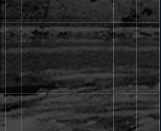
Photo
Copyright @ Mara Lavitt |
It’s
a simple presentation, much of it clearly derived from the basic
work in Cambodia: the participants gather, tell their stories, naturally
expand their telling into dance and song. Those segments are punctuated
by Noorlinah Mohamed’s video work, which takes us directly
to the places we hear about the labor camp village, the Tuol Sleng
museum and its archive of the dead. Sometimes the sequences have
documentary directness, sometimes they conjure, as when masses of
black beetles swarm out of eroded walls after a rainstorm. What
we see is supported by the soundscape of Japanese composer Yen Chang,
who provides a setting, mostly his own voice electronically altered,
for everything but the dance. That happens in silence.
It also happens in rehearsal clothes, except for the purple sash
Em Theay wears to indicate her royal patronage. At first, she had
balked at the idea. It wasn’t the classical dance without the
rich gold costumes and elaborate headdresses. But after a few weeks,
she began to get the sense of it. She saw they were constantly moving
in and out of personal stories. Even the dances lakron krabach boran
were being performed as personal stories. She would just get up
and remember her favorite sequence. That’s how she chose to
enact it. For Keng Sen, as an outsider, that was very impressive:
the ability to slip in and out of joy and sorrow in a way that is
almost impossible to understand: "They’ll be laughing
one minute and the next they’ll be back in a moment when the
tears come."
In one of the emblematic passages that seems to confirm the title,
we watch as Em Theay, Thong Kim Ann and Kim un Thom teach Noorlinah
Mohamed their art. Just as with their students in Phnom Penh, they
guide her body for her into the proper positions, gently but firmly
in spite of the evident pain. The knowledge is passed, even beyond
the borders of geography and history--a continuum. If the traditional
forms were somehow retrieved perfectly, their performance now would
have an unavoidable museum quality. Only by moving the art through
its attempted destruction on to a broader stage will it not only
survive but revive.
|
|


